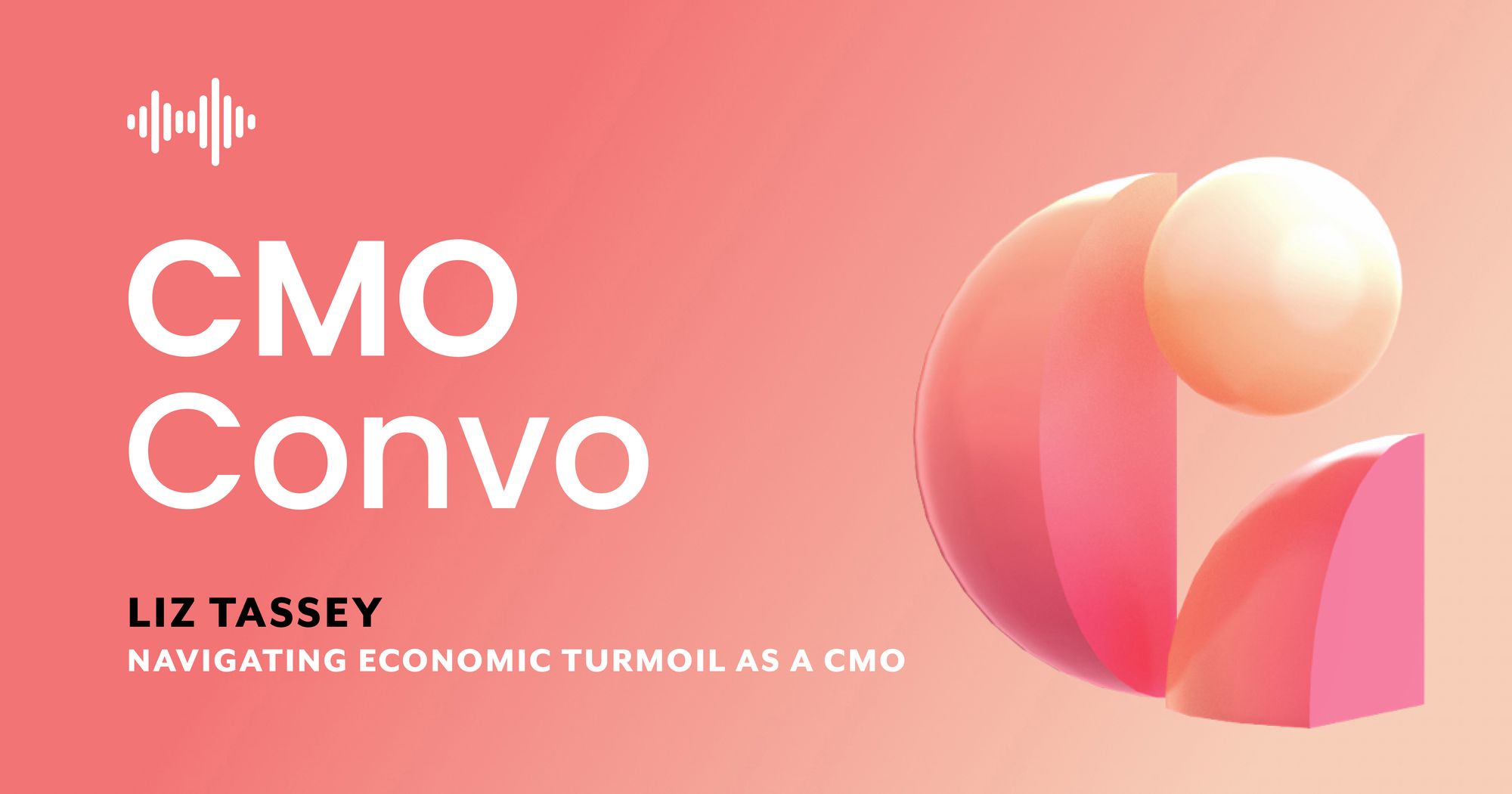It can often feel like your CMO role goes through peaks and troughs. At one point, you're flying high with massive growth, the next, you're scrambling to get any results at all. But rather than raging against these fluctuations, Karen Peterson, CMO of Lendio, has come to recognize them as cycles, cycles that reflect the seasons.
So what should you be doing during the hard times of Winter? What do you need to do to really enjoy the warmth of Summer? We spoke to Karen about what you need to do as a CMO to not just survive your cycle of seasons, but actually thrive.
Originally an episode of CMO Convo, now available in written form below if you want to enjoy it in peace and quiet (or with heavy metal music blasting, you read how you want to read).

Read on for what we discussed!
Karen’s background and role at Lendio
Hi, Karen, and welcome. Today, we're going to be talking about the seasons of CMOs and how your time as a CMO can fluctuate depending on what's going on around you. But before we get into that, could you tell us a bit about yourself and why we're speaking to you today?
I'd love to. I’m the CMO at Lendio, which is a small business solutions provider for all things financing. We help to even the playing field and make sure that small businesses have access to the capital that they need to both survive and thrive. It's a really rewarding business to be in. The mission is near and dear to me as my husband has been a small business owner for many years.
Previously, I was the CMO at a company called BrainStorm. Before that, I was at Ancestry for the bulk of my career. I ultimately grew to be the CMO before I left.
So I’m a longtime CMO and I’m passionate about all things marketing – it’s one of my very favorite subjects to talk about. I honestly can't imagine people choosing any other career because it's so rewarding and fulfilling. At the same time, I'm glad they do because some of my best partners are in other disciplines all across the organization.
Being in small business loans, your company must have felt the weight of a lot of external factors in the last couple of years, as a lot of small businesses have been struggling. Being aware of those external factors has got to be a big part of your role.
Absolutely. When I joined Lendio in 2020, it was the beginning of COVID, and the paycheck protection program had just launched. The organization was full steam ahead to try and save small businesses. I've never experienced anything like it.
It was super rewarding but wild to join at that moment in time. There was a lot to catch up on really quickly. There was no time for your normal slow onboarding, where you’re paying attention, and learning the organization. I had to just get in and start helping right away.

The seasons of CMO
That ties into what we're talking about today: the seasons of CMO. How did you come up with this way of addressing the CMO role?
It's based on the experience that I've had and looking back with a broader perspective to see how things have evolved. Now that I’ve been a CMO in multiple companies over many years, I’ve started to notice certain patterns.
Every marketer knows you have to get in and understand your customer, your industry, your market, and everything specific to that particular company role. But also, there are so many parallels and similarities. I’ve always been at growth companies, and you start to see those inflection points. Even though the circumstances might be different, the situation starts to feel familiar.
Over the years, one of the things I've thought about is how people respond to certain circumstances and swing the pendulum too far in the opposite direction. There’s a tendency to overcorrect. I've tried to pride myself on not being so extreme and finding a solution in the middle with more longevity. Recognizing patterns allows you to do that.
Being aware of those patterns also allows you to respond more effectively. If you know there are going to be ebbs and flows, you can plan ahead.
The last two years have taught us a lot about being prepared for unusual circumstances in just about every industry, and being aware of these potential changes should set CMOs up for better things in the long run.
I completely agree. That's why I love the concept of seasons. I love it anyway; I grew up in Virginia, where you get all four seasons. My daughter is even called Autumn. Knowing what's ahead after the season you're in always brings a lot of hope and perseverance, especially in times when it feels kind of hard.
Knowing what lies ahead and that any big change requires some discomfort means that instead of reacting like, “This feels hard and messy, and there's no clarity,” you take a step back and go, “Okay, that's normal. That's what happens right before there is clarity.” That's what usually happens before you start to understand that there’s a need for alignment, focus, and vision. That gives me the ability to ride those waves without overreacting.
Winter
We're breaking things down into the four seasons today. It makes sense to start with winter because a lot of CMOs are going through winter right now. In this context, what does winter mean for CMOs?
There are two sides to winter. One side of it is you're hunkering down and animals are going into hibernation. It's also a season where, particularly because we're based in Utah, there's a wild amount of incredibly active outdoor sports. It's not all hibernation; there’s also a lot of activity. We’re both hunkering down and preparing for growth.
Every CMO is always trying to balance short-term revenue goals with long-term needs. This can even be based on near-term performance indicators versus investment in branding and those types of things.
You always have to have your foundation built. You have to be making money and showing strong performance before you can hit that inflection point of growth or even invest in a lot of the brand areas.
You don't hear about companies that have beautiful branding but are not making money because they don't survive. Having your resources and your foundation built is about how you store up reserves for the growth that comes in spring.
You also need to think about the core areas that need to be built and what needs to be put in place when it comes to your team. When I came to Lendio, the team had about 10 employees, and we were really focused on our performance and demand marketing and some content around SEO. We also had a small PR team.
I knew, having talked to the executive team and the CEO, what the vision of the company was. Once I was really clear on that, I could leverage my experiences to think about the roles and disciplines that need to be put into place to ensure future growth.
One of those disciplines was lifecycle marketing. As performance marketing hits a point of diminishing returns, you have to diversify the channels and bring in prospects that can be nurtured over time.
That’s what winter is about: building, gathering, preserving, and making sure that you're planning for when that growth moment comes.
That kind of change, especially at these points of growth, can be uncomfortable. Within marketing, what often happens is that people who’ve had really broad roles can find themselves in much deeper and more narrowly defined roles as the team grows. That's different, and it can be hard, but that discomfort will allow you to set up the organization for scale in the future.
You've already flipped the script on how we tend to think about winter, which is as a time to do nothing but hibernate and survive. Thinking about those lull times as preparation for the upturn is a great way of looking at it.
How do you know when you're in the winter stage? Are there any indicators you should be on the lookout for as a CMO?
One of them is when there’s an inflection point of growth coming. If there’s a spring ahead, if a company is in that phase where you want to invest for growth, that's a clear indicator that it’s winter. You need to take a broad perspective to see what’s missing and what kind of resources you need to line up.
There's also an opportunity for growth if there's an organization that doesn't exist, or, say, alignment between marketing and product could be stronger. Similarly, you might be in a B2B organization and see that there’s an opportunity for the sales organization to become more marketing-enabled. It’s about that kind of awareness and seeing where the pockets of potential growth are.
So would you say you’re looking internally rather than externally, during winter?
Yes, and every CMO, when they come to an organization, should start with that moment in time because it helps you to get closer to your team and their talents.
There are always people within the team who have massive growth potential; those are the team members you want to invest in to make sure they have big opportunities and you can retain them. Sometimes some people are ready for a change of role, and they want to learn some kind of differentiation across marketing. That's another great opportunity.
Getting to know your team’s resources, talents, and opportunities is one layer. You also need to have the context of the company’s needs. Sometimes certain employees or roles fit a certain phase for the company, but now that role isn't as critical or needs to be evolved. Using that period to assess and figure that out is really powerful.
Spring
One of the best ways to get through winter is to remember that spring is just around the corner. What does spring look like in the seasons of CMO?
Spring is the state of new growth and new opportunities. All of your investment of time throughout that hard season that you've been through starts to blossom into results. You start to accelerate and gain momentum. You start to see your team members thrive. Spring is such a fun season.
I don't want to add complexity to the framework, but within each season, you're looking at yourself and how you lead the team. You also look at the team and the individuals on it against the backdrop of the company and the market.
And so there are layers, but springtime is when people start to thrive, and it's when you start to put key roles into place, and then you see them hit their stride. It's such a rewarding season.
Spring takes work well. To continue with the metaphor, you've got new shoots coming through and you need to tend them. You also want to make sure you haven't got weeds in the garden. In other words, you still need to be on the ball as the CMO during this stage.
Weeds are exactly what I was thinking of. Wouldn't it be great if your garden grew without any weeds at all?
You’ve also got to think about pruning, which is one of the hardest parts of a leadership role. You're looking at your team, and sometimes roles become redundant. Sometimes the role surpasses the skill set and it can’t be trained or up-leveled. It’s hard because marketers tend to feel passionate about people, but the most amazing, talented people are going to be impacted by the less strong players on the team.
In almost all circumstances, if you're doing right by the customer, then the company, then the team, and then the individual in that order, they're almost always better served. I've never seen a situation where someone doesn't end up finding a role that is a better fit for them at that moment in time.
Companies are living and breathing and changing. It's a hard subject to talk about, but it's a reality that good leaders try and build solid teams and are aware of changes that need to be made.
Summer
Hopefully, that team will be then able to enjoy the lovely climes of summer. Let's talk about what summer means for a CMO, besides being on the beach.
Summer for us was when we were coming out of the changes brought by the pandemic. The PPP loan program ended up lasting almost two years, from the beginning of March of 2020 through to the end of 2021.
The whole company had pivoted to make sure that we were servicing the financial institutions and the lenders that we work with as well as the small businesses. When that first happened, people were working around the clock, even sleeping at the office.
It had been a really intense season, so everybody was looking ahead and thinking, “Summer’s coming!” Even I thought this was going to end and we were going to go back to the core business.
It ended up that we had to unwind all the PPP data that was mixed up with our marketplace data. We had to transition back and we needed to accelerate our sales so quickly that there wasn't a pause. There was no relaxation. There was no beach. It was right back to a different kind of hard.
The summer piece was when the clouds were parting and we could see what we were working with. As we started to get back into the rhythm, and we had a month where we hit the aggressive targets that were set, it felt like a moment of celebration.
Summer doesn't last nearly as long as we want it to. Don't we always think that it just flies by?
Marketing is one of those businesses where the goalpost moves. You never get to the point where you're like, “I've done it! I have cracked the code on Google!” because Google will change. There is none of that, so you have to intentionally look at your wins along the way.
That’s what summer should be: a time for making sure that you take a moment to see how far you've come, purposely preparing for the next phase, knowing that there's always another thing coming. Not only is the next season coming but the whole thing's gonna circle back around.
I love the idea that summer is for celebrating, recognizing, rewarding, seeing how far you've come, and taking pleasure in your success.
That's incredibly important, particularly when times are hard. All too often, workers don’t get the praise they deserve for getting through difficult times.
Summer could also be a good opportunity to take stock of what your rivals are getting up to. To go with the metaphor again, summer’s when you see more people out and about, so it's a good time to see what your competitors' beach bods look like.
So true! It’s the perfect time to look at where you’re placed, not just within the company but in relation to the market.
Then you start to head into the end of summer when schools are starting and so is the football season. Then there’s Halloween and Thanksgiving… What a fun time!
Fall
Fall is a beautiful season, and it would be easy to talk about how much we love it all day, but what does fall look like to a CMO?
I think some people see fall as the dying off of so many things and a time for prep as you hunker down for the winter ahead. It can feel like the sad, withering season. I don't look at it like that at all. I see the brilliance of the colors. I see all of the activities. It's all about perspective, and your perspective always filters down to the team.
I think marketing teams are always looking to be inspired and to see the opportunity ahead, so I look at fall for a CMO as a time of transition. It's a time for looking at all the tools that you have and making sure they’re set up and ready.
Marketing is one of the most diverse organizations in a company. You have your data-driven types and some super creative folks; hopefully, both of them have a piece of creativity and data in what they do. Fall is an opportunity for looking at those resources and making sure that they're maximized.

Parting thoughts
That's a beautiful thing about the seasons: they all feed into each other, and they keep going around in a cycle, which is a hopeful thought for a lot of CMOs and people who have been through difficult times in business.
One of the things I love about the marketing world is that we’re actively working to stay ahead and evolve. That's understanding the latest technology, understanding the latest ways of attributing brand value, and looking to see what new channels are popular with your customers.
Everything I've just mentioned, which is just the tip of the iceberg, is always changing and evolving. If you as a marketer are not purposefully trying to better yourself and your team, you will fall behind. And so I think it's a fun place to be because you always have a push. You can't ever get comfortable – something unexpected will happen, so you have to stay agile and responsive.
You also deal with ambiguity all the time. The CMOs who are really differentiated are those that can thrive in that ambiguous environment and create clear paths out of what feels like chaos. And some of the greatest CMOs are the ones who have experienced all the seasons with the company. They have a broader perspective and the ability to stretch and pull in resources that will create longevity.
You’ve summarized everything we've discussed beautifully there, Karen. Thank you very much for joining us today. Word on the street is you have a way of applying this framework to CMO career paths – hopefully, we can talk about that in the future.
For now, do you have any final words to share with our readers?
We’ve talked a little about the role of a CMO being challenging and rewarding. I think the power is in the “and” – the fact that it can be both challenging and rewarding. It can feel like it's hard, and there's opportunity there. It can feel like there's ambiguity and the beginnings of clarity.
That powerful “and” gets you from season to season and gives you the ability to keep a broad perspective.
Want to learn how to handle the cycle of seasons as a CMO? Our CMO Fellowship course has everything you need to know, all from the practical experiences of CMOs who know how to handle whatever might come your way.




